For the first half of this story, please visit yesterday’s instalment.
Precocity may not be the first thing you’d have in mind from TOM’S D’ETAT (Smart Strike–Julia Tuttle, by Giant’s Causeway), who enters service at WinStar at $17,500 after only really seizing our attention at the age of seven. Nonetheless, he represents one of the most promising prospects of the intake.
For a start, he’s by a sire of sires out of a graded stakes-placed Giant’s Causeway mare whose own dam was a full-sister to Candy Ride (Arg). And nine consecutive triple-digit Beyers attest to the tough and consistent way in which, having initially required much patience of connections, Tom’s d’Etat ultimately reached his pomp.
His four-win streak from the GII Fayette S. permitted no doubt as to his Grade I caliber, albeit that was formally sealed only in the Clark S. Though geared down in the GII Stephen Foster S., his 1:47.30 barely missed the 1:47.28 track record set by Victory Gallop (Cryptoclearance) in 1999. He had beaten Improbable (City Zip) in Hot Springs on their resumption and was unlucky when that horse turned things round in the GI Whitney S., having stumbled out of the gate and been caught behind a dawdling pace. Their opening fees suggest we take that form at face value, but I remain convinced that Tom’s d’Etat had as much class on his day as any older horse operating round two turns this year. Despite maturing into a big, powerful physique, his mechanics were always very smooth and balanced.
It will be fascinating to see the WinStar system, which so reliably loads the engine for a young commercial prospect, helping a horse who will surely appeal as good value to any breeder possessed by the quaint notion that the object of a mating might be to produce a runner. Okay, so maybe he won’t be champion freshman. But with the right material, he is as eligible as any horse in this intake to sire a Classic Thoroughbred, which to me is kind of the point of what we’re all doing.
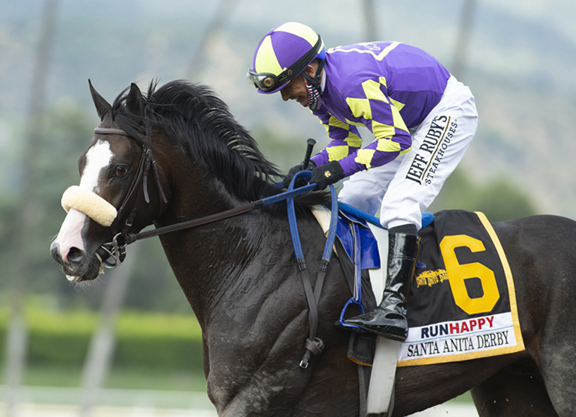
Honor A. P. | Benoit
As it happens, you could say much the same of one starting out at Lane’s End–except you might just say it a little louder, given a fee as tempting as $15,000. In terms of value, that makes HONOR A. P. (Honor Code–Hollywood Story, by Wild Rush) the neon standout among the new sires for 2021.
His scenic route into fourth in the GI Kentucky Derby was exasperating, his subsequent retirement heart-breaking, and it is the coldest of comforts to reflect that he remains the only colt ever to have beaten the winner. He did so decisively, too, while clocking a 102 Beyer in the GI Santa Anita Derby–no less than he had promised when chasing home the same horse in what proved primarily an educational exercise in the GII San Felipe S. The genius who was training him toward one day certainly wasn’t fazed when Honor A. P. was beaten in his rehearsal, but there was no accounting for the trip he got at Churchill. Hampered at the gate, he already had no chance when preceded by the whole field past the post first time. While the winner was not for catching, left to his own devices in front, the ground made up by Honor A. P. (while going an extra 49 feet) filled his admirers with confidence that he could yet confirm himself the best in the crop at the Breeders’ Cup.
Sadly, it turned out that his Derby effort had also been compromised by injury. But no more beautiful a horse goes to stud this year, as you might glean from his $850,000 tag as a Saratoga yearling. And now that he joins his sire at the farm that also gave us his breed-shaping grandsire, Honor A. P. can also recycle the excellence of a dam who won Grade Is at two and five. That longevity offers comforting reassurance for a horse confined to a light career, while the bottom line of his pedigree–largely seeded by iconic Classic influences–complements the sumptuous family of Honor Code in eventually extending to the great Myrtlewood.
It’s all there, then: perhaps physique above all, but also performance and pedigree. And all for one-fifth of the fee charged for the horse he outgunned fair and square in the Santa Anita Derby.

Global Campaign | Sarah Andrew
Myrtlewood also pegs down the bottom line of GLOBAL CAMPAIGN (Curlin–Globe Trot, by A.P. Indy), who similarly looks plenty of racehorse for $12,500 at WinStar.
A half-brother to Bolt d’Oro (Medaglia d’Oro), among just three foals delivered by their tragic dam, Global Campaign rounded off with a podium in the GI Breeders’ Cup Classic that came as no surprise to those who sat up and took notice when he returned from a nine-month layoff over seven furlongs at Gulfstream in the spring. He had to regroup after disappointing next time but did so in style, notably in making all for his Grade I in the Woodward S.
His second dam is a triple graded stakes winner whose half-sister produced triple Grade I sprint winner Zensational (Unbridled’s Song)–an unusually quick horse, for the sire, and that’s something of a pattern through this family. Myrtlewood speed filters through elsewhere, indeed: through Seattle Slew, as grandsire of Global Campaign’s dam; and through Mr Prospector, who recurs 3×5. I just wonder whether Global Campaign quite lasted home in the Classic, with all this speed packed down behind him (unpressured in the Woodward). Certainly with his half-brother a dual Grade I winner at two, I wouldn’t be surprised to see Global Campaign getting earlier momentum than Curlin-over-A.P. Indy might imply. (He himself was five days into his sophomore year when romping on debut at Gulfstream, his fulfilment ultimately delayed only by bone bruising.)

Complexity | Sarah Andrew
Like Honor A. P. and Volatile (Violence), COMPLEXITY (Maclean’s Music–Goldfield, by Yes It’s True) raised the bar as a yearling, at $375,000 the most expensive yearling in his sire’s third crop. He, too, looks sensibly priced at $12,500 with Airdrie.
The way he stitched everything back together at four, after losing the thread of juvenile promise, left no doubt as to his elite quality and commercial appeal. A ‘TDN Rising Star‘ on debut at Saratoga, he then ran Code of Honor (Noble Mission {GB}) into the ground in the GI Champagne S. and was duly fancied for the GI Juvenile when bombing out at the Breeders’ Cup. He was really back on song this summer, including when just collared after contributing to molten fractions in the GI Forego S. He then steamrolled Code of Honor once again in the GII Kelso H., earning a 110 Beyer, before a creditable run at the Breeders’ Cup when again pouring coal into the pace out wide.
Complexity is another of those that bring back some retro names–first three dams by Yes It’s True, Digression and Torsion–but it’s obviously working as his unraced mother (half-sister to a GII Demoiselle S. winner) has already produced Valadorna (Curlin) to be runner-up in the GI Breeders’ Cup Juvenile Fillies. No question about it, this guy had a ton of ability on his day and, with such a good farm behind him, looks a potential player in the freshmen’s championship.
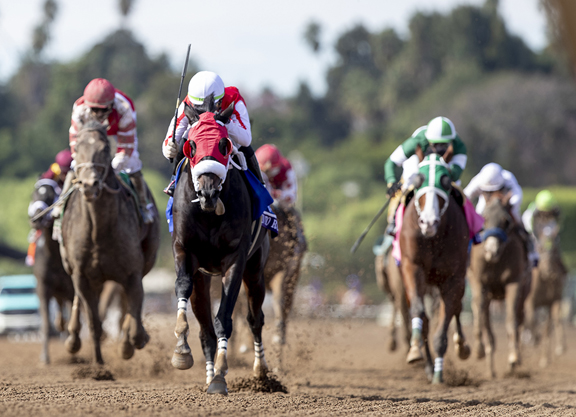
Spun to Run | Breeders’ Cup/Eclipse Sportswire
A third horse introduced at what feels like a market sweet spot of $12,500 is SPUN TO RUN (Hard Spun–Yawkey Way, by Grand Slam) at Gainesway. Few people took his defeat of Omaha Beach (War Front) at the Breeders’ Cup as too literal a guide to their relative merits, given the way the race developed that day, but the 109 Beyer he nonetheless earned was his third consecutive triple-digit. Though unfortunate to be confined to single start when kept in training this year, he confirmed his caliber in beating all bar Maximum Security (New Year’s Day) in the GI Cigar Mile H. His dam won a Saratoga stakes at two, and a paternal grandson of Danzig who showed so much dash at a mile has a good ring to it.
‘TDN Rising Star’ GIFT BOX (Twirling Candy–Special Me, by Unbridled’s Song) didn’t surface at all in 2020, but at $10,000 it’s well worth reminding ourselves what a splendidly old-fashioned campaigner has now joined his sire at Lane’s End. He was better than ever at six, nosing out ‘Rising Star’ McKinzie (Street Sense) for his Grade I success in the Santa Anita H. and then running Vino Rosso (Curlin) to three-parts of a length in the GI Gold Cup at the same course.
I really like the fact that his dam, a half-sister to G1 Dubai Golden Shaheen winner Our New Recruit (Alphabet Soup), has produced an equally hardy and classy daughter in dual Grade II winner Stonetastic (Mizzen Mast). By combining two branches of Fappiano, moreover, Gift Box is exactly what his name suggests for a lot of other blood. He was precocious enough to notch a 93 Beyer breaking his maiden before running third in the GII Remsen S., but longevity and two-turn guts are his trademarks–and heaven knows the breed needs plenty of both.

Gift Box | Benoit
PROMISES FULFILLED (Shackleford–Marquee Delivery, by Marquetry) is in much the same boat, in starting out at WinStar off $10,000, having disappeared this year after establishing toughness and quality through three preceding seasons. He, similarly, got going early enough to win his first two and then make the frame in the GII Kentucky Jockey Club S.; after being tempted astray on the Derby trail, he showed his true zip back in trip and won his Grade I in the Allen Jerkens S.; and at four put up a trademark blitz for the GII John A. Nerud S. in 1:21.75. His dam, twice graded stakes-placed, has managed to produce a multiple stakes winner by Cowboy Cal, but his real calling card is pure track speed. Indeed, his farm is highlighting how he won the first call in 15 of 17 starts, and you can easily picture him achieving corresponding early thrust in his new career.
ECHO TOWN (Speightstown–Letgomyecho, by Menifee) is another Allen Jerkens winner, launched at the same fee at Ashford. If you are only going to manage a single season, it helps if you can demonstrate such soundness: he spread 10 starts evenly between Fair Grounds in January and the Breeders’ Cup. And while he presumably owes a Kentucky stud career pretty well entirely to his standout Saratoga success, where the favorite bombed out, he was certainly a stylish winner on the day and does have something to work on genetically. His dam won her first three, including a Grade II, before derailing in her only other start, and has also produced GIII Gotham S. winner J Boys Echo (Mineshaft). And a lot of people are going to like the fact that she is by a grandson of Storm Cat, who recurs as damsire of Speightstown.
The team that brought us Gift Box has meanwhile housed HIGHER POWER (Medaglia d’Oro–Alternate, by Seattle Slew) at Darby Dan, where he, too, opens at $10,000. And he’s in a similar mold, a hardy old stager round two turns who matured through four seasons, the highlights being a five-length rout in the GI Pacific Classic (107 Beyer) and a podium in the GI Breeders’ Cup Classic. He has a solid-enough page, too, as a half-brother to Alternation (Distorted Humor), sire of Serengeti Empress, out of a multiple graded stakes-placed sibling to Canadian Horse of the Year Peaks and Valleys (Mt. Livermore).
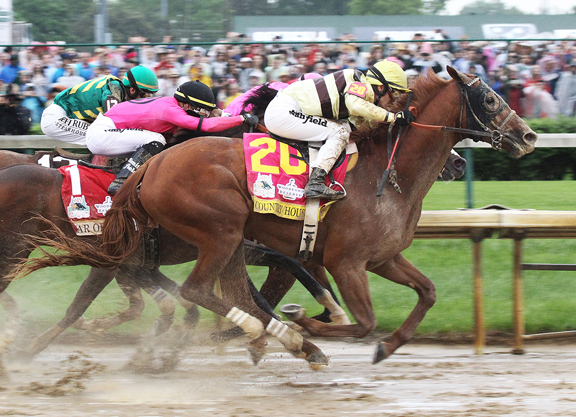
Country House | Coady
Mind you, he will do very well to match the value available about his new neighbor ‘TDN Rising Star’ COUNTRY HOUSE (Lookin At Lucky–Quake Lake, by War Chant). To be fair, at $7,500, newcomers right across the Bluegrass will be embarrassed by the contrast.
True, Country House has to be led out to the crossroads to remind everyone of his existence, having unfortunately failed to get back onto the track when kept in training at four. You can see why that felt like an imperative, the horse having been given so little credit for the merit of his own Kentucky Derby performance while everyone debated the disqualification of the first past the post. But let’s take a step back and remind ourselves that he overcame a rough trip from gate 19 to beat 18 rivals including several–including Improbable, Game Winner (Candy Ride {Arg}) and War of Will (War Front)–who are being launched at much higher fees. Forget his long odds on the day: he had been brought skillfully to the boil by his trainer, taught to pass horses behind War of Will in the GII Risen Star S. and Omaha Beach and Improbable in the GI Arkansas Derby.
Yes, we know that a son of such an underrated sire will likely be undervalued himself. But Country House not only doubles up Danzig–responsible both for his own damsire and for that of Lookin At Lucky–but has a complementary mirror of No Class, the Sam-Son matriarch who belied her name as dam of four champions. Her celebrated daughter Classy ‘n Smart (Smarten) produced Lookin At Lucky’s sire Smart Strike, while her son Sky Classic is the sire of Country House’s Grade I-placed granddam.

Promises Fulfilled | Sarah Andrew
From just four foals and three starters, Country House’s dam has also produced graded stakes winner Mitchell Road (English Channel); while her half-brother (also by Lookin At Lucky) is multiple Grade I-placed Breaking Lucky. Country House himself obviously came into his own with a proper test round two turns, but his dam and third dam were both sprinters so there’s more latent speed to draw out than you might assume. Bottom line is that Country House, given the right material, would be perfectly entitled to sire a colt able finally to secure him overdue credit under the Twin Spires. The only barrier is whether people with the fast, well-bred mares that he deserves are smart enough to save so much money on a cover fee, or view a $7,500 stallion as beneath their dignity.
Many a commercial breeder, you suspect, will need less persuasion to roll the dice at the same fee on a very different type in INSTAGRAND (Into Mischief–Assets of War, by Lawyer Ron) at Taylor Made.
Here’s a thought that tells you a lot about our industry. Had he happened to retire after the GII Best Pal S., there would have been a stampede of breeders ready to use him at nearly any money. At that point he was a $1.2 million Gulfstream 2-year-old bullet who had then won by 10 lengths both on debut (in :56 flat) and now in a Grade II. But the flame has dwindled through two campaigns since, meaning that he must start at a fee feasible for a gamble. Bearing in mind that second and third dams were both graded stakes winners, you can be sure that plenty of pinhookers will be keeping an eye on his first crop.
Two of the three stallions in the bargain basement of this intake have been recruited at Crestwood, itself an immediate recommendation. This farm deserves much respect for the way it fights its corner, against much bigger rivals, with a roster always full of interest.
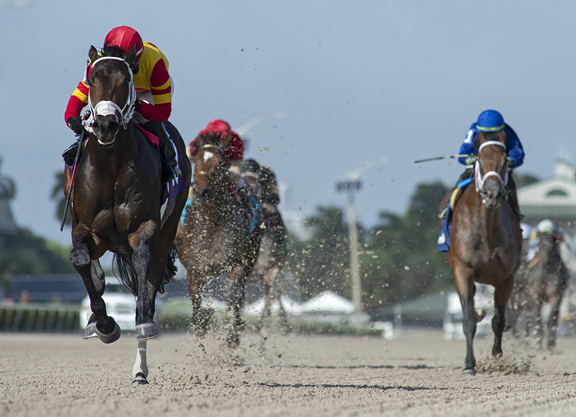
Caracaro | Ryan Thompson
CARACARO (Uncle Mo–Peace Time, by War Front) only managed four starts but shaped very well, six months after his dashing ‘Rising Star‘ maiden win, when beaten a neck in the GIII Peter Pan S., before proving least embarrassed among the pursuers of Tiz the Law (Constitution) in the GI Travers S.
His first three dams are by War Front, Unbridled and Storm Cat, the middle one being the very smart Santa Catarina, a Grade II winner who was placed three times in Grade I company as a juvenile. And their line traces to the Phipps matriarch Lady Be Good, via the branch that also gave us top-class European milers Zilzal (Nureyev), Polish Precedent (Danzig) and Culture Vulture (Timeless Moment).
We know to expect this kind of thing at a farm that understands how aristocratic lineage can elevate a stallion past the perceived track limitations that keep them affordable. Sure enough, YORKTON (Speightstown–Sunday Affair, by A.P. Indy) is backed up by a terrific family–and, in contrast with Caracaro, also bears another farm trademark in having thrived through five seasons of racing. Albeit he did not win beyond Grade III level, he was as committed as ever at the age of six and showed his form on three surfaces.
But what makes him well worth a punt at $5,000, not least in view of a $1-million breeders’ incentive program, is one of the very best families in the book–and one that has been seeded accordingly: first four dams, this time, by A.P. Indy, Sunday Silence, Nijinsky II and Mr. Prospector. The third dam, in fact, is Gold Beauty’s daughter Maplejinsky, the half-sister to Dayjur (Danzig) who herself produced Sky Beauty (Blushing Groom {Fr}). This dynasty just keeps on giving, with Violence (Medaglia d’Oro) and Guarana (Ghostzapper) among its recent adornments, and Yorkton has the build to support the farm motto: “We raise runners.”
We round off our survey with BRAVAZO (Awesome Again–Tiz o’ Gold, by Cee’s Tizzy) at Calumet, standing at $6,000. There were times when it felt as though a race could only be accorded Grade I status if he were in the gate and, if he couldn’t always show why, he certainly had his moments in banking $2 million–notably when within half a length of derailing the Triple Crown express of Justify (Scat Daddy) in the Preakness. And you have to admire a horse that can miss the Clark by just a neck on his 11th sophomore start, the last eight at elite level.
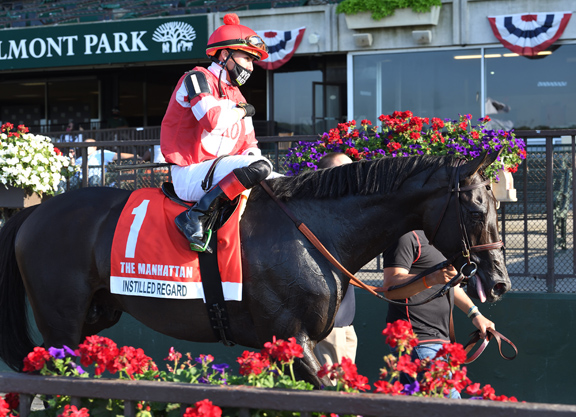
Instilled Regard | Susie Raisher
Ducking under the wire in time for inclusion in this review is INSTILLED REGARD (Arch–Enhancing, by Forestry), whose name has just been added to the roll call of rookies. He has been announced at $12,500 by Taylor Made.
If he’s last, he’s certainly not least–having maintained high standards in different environments through four seasons: he was Grade I-placed on dirt at two, fourth in Justify (Scat Daddy)’s Derby and rounded off with a :22.31 split to notch his Grade I on grass in the Manhattan S. That longevity augurs extremely well for a $1.05-million 2-year-old, and it’s all backed up by a top-class Phipps pedigree.
For his second dam is champion Heavenly Prize (Seeking the Gold), who herself produced a Manhattan winner in Good Reward (Storm Cat), as well as the dam of Grade I winner Persistently (Smoke Glacken); while fourth dam is the blue-hen Blitey (Riva Ridge), mother of three Grade I winners plus another at Grade II level.
I love matching Blitey against a name as resonant as Courtly Dee in the bottom line of Arch, himself such a wholesome influence. In fact, Instilled Regard offers as good a “stairwell” up and down the fourth generation as you can find anywhere in this intake. Having finished so strongly in both his starts at 10 furlongs, in the Derby and the Manhattan, arguably his stamina was never fully tapped: had he made the gig, he might well have given the Euros a run for their money in the GI Breeders’ Cup Turf.
If that won’t be received as the most commercial of recommendations in this myopic marketplace, then don’t forget the way Instilled Regard got himself rolling on the winter Triple Crown trail. This looks a really interesting new option for any breeder far-sighted enough to seek a Classic horse for any theater.
CHRIS McGRATH’S VALUE PODIUM
Gold:
Honor A. P. ($15,000, Lane’s End)
Staggering physical, and the only colt to beat the champ
Silver:
Country House ($7,500, Darby Dan)
The least credited Derby performance ever gets a corresponding fee
Bronze:
Global Campaign ($12,500, WinStar)
A family that loads up the speed

The post Value Sires for 2021, Part II: New KY Sires appeared first on TDN | Thoroughbred Daily News | Horse Racing News, Results and Video | Thoroughbred Breeding and Auctions.
Source of original post
















